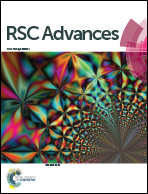Nano-grained ZrB2 thin films as a high-performance diffusion barrier in Cu metallization
Abstract
Nano-grained ZrB2 thin films are prepared by radio-frequency (rf) magnetron sputtering and, the thermal stability and the diffusion barrier performance are evaluated at elevated temperatures. It is demonstrated that the as-deposited ZrB2 thin films can effectively block the intermixing of Cu and Si atoms up to 700 °C. But substantial atomic diffusion occurs at 725 °C resulting in high-resistance CuSix compounds. A Cu3Si phase is formed at 750 °C and it has an epitaxial relationship with Si substrates, like, Cu3Si (000![[1 with combining macron]](https://www.rsc.org/images/entities/char_0031_0304.gif) )//Si (1
)//Si (1![[1 with combining macron]](https://www.rsc.org/images/entities/char_0031_0304.gif) 1) and Cu3Si (1
1) and Cu3Si (1![[1 with combining macron]](https://www.rsc.org/images/entities/char_0031_0304.gif) 00)//Si (
00)//Si (![[2 with combining macron]](https://www.rsc.org/images/entities/char_0032_0304.gif)
![[1 with combining macron]](https://www.rsc.org/images/entities/char_0031_0304.gif) 1). Although the crystallization of nano-grained ZrB2 thin films is enhanced at 700 °C, the high thermal stability makes it possible to be exploited as a diffusion barrier in Cu interconnects.
1). Although the crystallization of nano-grained ZrB2 thin films is enhanced at 700 °C, the high thermal stability makes it possible to be exploited as a diffusion barrier in Cu interconnects.


 Please wait while we load your content...
Please wait while we load your content...